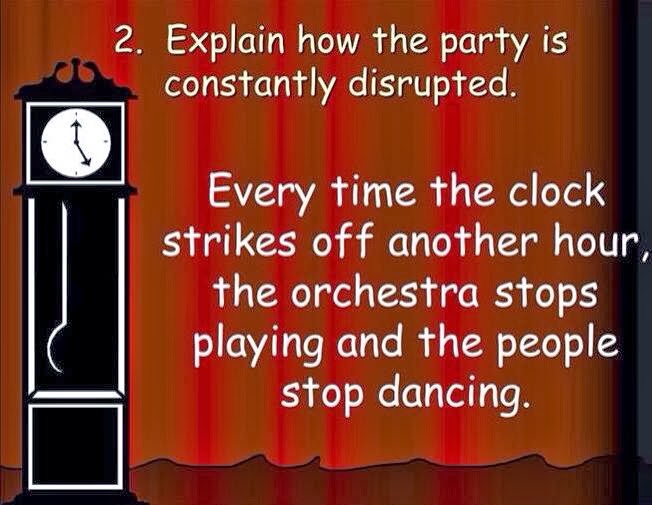Sunday, January 26, 2014
Lessons must be learned.~
The central message of "The Masque of the Red Death" is perhaps best understood as the inevitability of death. Prospero walls himself and his courtiers inside his palace to attempt to avoid the Red Death, a horrible plague that ravages the countryside. In sharp contrast to the suffering outside, they hold a lavish costume ball. But among the costumed guests is Death himself, who has slipped in "like a thief in the night," and he strikes down first Prospero and then all of the other guests. Their wealth, power, and privilege could not save them from the inevitable, and their attempt at escaping the plague comes across as decadent and arrogant even as it is fearful. The final line of the play is chilling, and sums up the play's message succinctly: "And Darkness and Decay and the Red Death held illimitable dominion over all.”
What is the significance of the rooms?
Rooms are going east to west signifying the life cycle.
Going from east to west;
Going from east to west;
BLUE -> birth PURPLE -> youth (beginning of youth) GREEN -> youth ORANGE -> adult hood VIOLET -> elderly BLACK -> death RED -> reserved for blood and fear
All about allegories and irony.~
The Masque of the
Red Death is a story of symbolism and allegory. Everything from the arrangement
of the rooms to Prince Prospero's name has a secret meaning.
When the Prince's
name comes up, it brings to mind prosperous, rich, extravagant people. Prince
Prospero represents someone who is fortunate. He would have the best luck. His
name is ironic because, in the end, he ends up dying a terrible death.
The rooms are
arranged from east to west. In the east, the rooms are bright, like the
sunrise. In the west, the rooms are darker, more ominous colors, sunset. The
arrangement of the rooms also symbolizes a human life.
The ebony clock
that terrifies everyone represents both the time of a life and death. It follows people wherever they are. When the
clock rings, it reminds the people inside that death is upon them and people
outside are still dying. Even though they turned their backs to the Red Death,
it doesn't mean it is gone. It still kills people they once knew. When the
clock finally stops ringing, everyone in the castle is dead.
The torches in
each of the rooms represent life. In the final black room, it is the only bit
of light in the room. It, and all the torches in the other rooms, goes out when
Prince Prospero dies.
People in the
book are completely afraid of the black room in the house. It represents the
fear of death. The windows in the room are blood red and cast a creepy feeling
over the entire room.
There is a theme
that there is no way to run from death and fear. It is a part of life that
nobody can run from no matter how much they try.
Character Analysis
 |
Prince Prospero - Was a wealthy nobleman and the ultimate victim of the Red Death. Prince Prospero’s wealth turns out to be irrelevant in the natural cycle of life and death.
|
 |
Mysterious guest -
The embodiment of the Red Death. Donning the gruesome marks of the
plague as his costume, the mysterious guest brings death to those who deny
their own mortality.
|
The Masque Of The Red Death (overview)
The Terror Of Bubonic Plague
Plague is a bacterial infection found mainly in rodents and their fleas. But via those fleas it can sometimes leap to humans. When it does, the outcome can be horrific, making plague outbreaks the most notorious disease episodes in history.
The map show clearly the spreading wave of Black Death(caused by bubonic plague) across Europe (1347-1351) as people panicked & fled to avoid the pestilence. There is also some evidence that these people, by fleeing to avoid the illnes s, actually helped to spread it faster and further.
EDGAR ALLEN POE (1809-1849)
EDGAR ALLEN POE (1809-1849)
Edgar Allan Poe was a famous American poet, short story
writer, journalist, and literary critic who lived from 1809-1849. He was born
in Boston on January 19th, 1809 and was orphaned at an early age, after which
he was sent to live with a foster family (The Allans) in Richmond. He was never
officially adopted by the Allans and he was eventually disowned by the family. Poe won a short story contest in 1833, and two years later
became a literary critic for the magazine (The Southern Literary Messenger).
Shortly after, he then married his 13-year-old cousin, Virginia in 1836. He
became nationally famous upon the publication of his poem The Raven in 1845. His life was marred by infrequent but intense drinking bouts
which gave him a bad reputation. However, he continued to produce excellent
short stories (Murders in the Rue Morgue, The Gold Bug) which brought him
acclaim in America, England, and especially in France. Many of Poe's stories
take place in Paris. (The French poet Baudelaire translated many of Poe's
works). Unfortunately, after the death of Poe's wife (1847), he fell
apart and died two years later on October 7, 1849. Poe's controversial life and
reputation have earned him the following comments no less:
Subscribe to:
Comments (Atom)










.jpg)